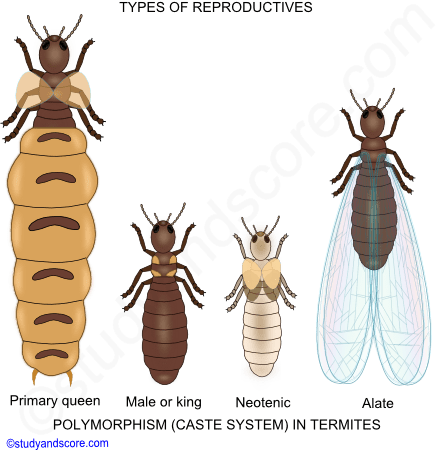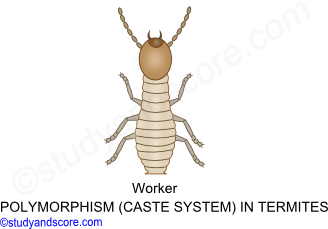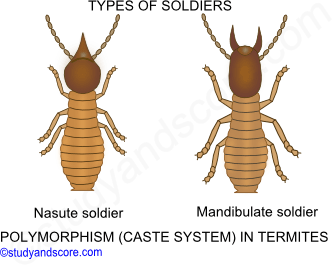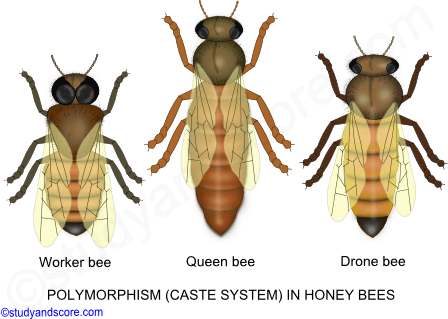Few animals belonging to the order Isoptera and Hymenoptera of class Insecta, exhibit social behaviour. These animals live in complex societies and are referred to as eusocial. Eusociality is an extreme form of social behavior found in just a few types of animals and is characterized by:
The following are the characters commonly possessed by all the social insects:
| Habits | Honey bee | Ants | Termites |
|---|---|---|---|
| Position of nest | Trees | Leaves, wood | Wood, ground |
| Material of nest | Wax | Leaves, wood, soil | Wood, soil |
| Shape of nest | Hexagonal cells | Chambers & galleries | Chambers & galleries |
| Nest built by | Females & workers | Females/males & workers | Female/male & workers |
| Population of nest | 35-50 thousand | 600 thousand | Several millions |
| Brood nature | Perennial | Perennial | Perennial |
| Brood food | Pollen & Nectar | Vegetables, wood, insects | Wood & insects |
| Feeding type | Progressive | Progressive | Progresive |
| Swarming | Yes | In some species | Yes |
The termite life cycle has the three castes, the reproductives, the soldiers and the workers. Due to the fact that termites are hemimetabolous insects, even the nymphs take part in the social life and have their specific tasks to accomplish. In case of termites, once the caste of an individual is determined, development into other castes is still possible. Soldiers also called as inter-castes, may turn into workers or even into reproductives, if there is a shortage of individuals of other castes. This process of development in to other castes is controlled by pheromones. In the case of the queen, there is a specific ‘queen’ pheromone, preventing other individuals from turning into queens. Only if the queen is removed or dies, does the lack of the specific pheromone promote the development of a new queen.
Reproductives- Reproductives have compound eyes and are more or less brown due to their sclerotized cuticle. Developing reproductives have wing buds, wings or wing stumps. Reproductives can be further divided into:
Alates: They are young winged reproductives of both sexes. From time to time about 100 to 1000 alates leave the colony for a mating and colonizing flight. After mating a pair settles down at a suitable site like a rotting scar on a tree to establish a new colony.

De-alates: These are the alates that cast their wings after the colonizing flight and successively turn into queens and kings. Initially only a few eggs are laid and brought up by a female de-alate. As the number of individuals in the colony grows, more workers are available to help the young queen to care for the brood. After three to five years the number of individuals is already so large, that the colony of this pest species can turn into the damaging stage.
Queen and king: They are the main reproductive individuals in a colony. Once there are many workers to help the queen, her only job is to produce tremendous number of offsprings. A large queen may lay more than 1000 eggs per day. The life span of a queen can be as much as 50 years.
Neotenics: They assist the queen in laying eggs, once her productivity decreases. When the queen has died or deteriorated, one of the neotenics takes her place and so they are also known as Secondary queens. Hence, the removal of a queen from her colony does not necessarily mean the end of the colony
Workers: They are sterile, wingless and blind males and females. Their cuticle is unpigmented and not hardened; therefore the animals are confined to a dark and moist environment. Workers build the nest and galleries, they fetch food, care for the brood and feed reproductives and soldiers. The life span of a worker is about one to two years.

Soldiers: Just like workers, they are also sterile, wingless and blind males and females with an unpigmented, unsclerotized cuticle. Soldiers defend their colony from intruders by the use of powerful jaws or by ejecting a white sticky repellent from an opening on their head. Soldiers can’t feed themselves; they have to be fed by workers. Usually the number of soldiers is much smaller than the number of workers. Soldiers can be mandibulate or nasute depending on the species. Therefore soldiers can be used for the identification of termite species. The life span of the soldiers is about one to two years.

Honey bee is a social insect. The nest of the honey bee is known as the bee-hive. The population of an average sized colony consists of 30 to 50 thousand individuals.
A colony is termed ‘weak’ or ‘strong’ according to the number of worker bees it possesses. There are three types of individuals in a colony, namely the Queen, worker and drone. Due to the existence of several morphological forms, bees are said to be a polymorphic species. All these three castes depend on each other for their existence. Drones and queen are concerned only with reproductive function and so the workers have to perform all the other duties of the colony.
The following is the description of each type of member of the bee colony,
Queen: It is a diploid, fertile female. The presence of queen in a colony is a must. The size of the body of queen is much larger than other castes of bees of the colony. Her legs are strong as she always has to walk about on the comb. The queen has a sting curved like a scimitar at the tip of the abdomen, which is a modification of the egg-laying organ known as ovipositor. The sting serves as an organ of defense. She never uses it against anybody except her own caste. The queen is responsible for laying eggs for a colony. She lays about 1000 to 1500 eggs every day and lives for about two to three years. She lays both fertilized eggs (from which females develop) and unfertilized eggs (from which males develop).

Worker: It is a diploid, sterile female. The size of a worker is the smallest among all the other castes but they constitute majority population of the bees in a colony. The following are the functions of worker bees,
Numerous adaptations have occurred in the worker bees for performing various functions. The body is covered with branched hairs so that when a bee visits a flower, pollen grains adhere to the hairs and other parts of the body. The worker cleans off pollen grains with special structures, the antenna cleaners on each foreleg, pollen brushes on all legs and pollen combs on hind legs. All pollen is stored in the pollen basket present on the outer surface of tibiae on hind legs.
Water and nectar are gathered by means of sucking mouthparts which are modifications of the maxillae and labium. Workers are provided by a sting at the tip of the abdomen which is a modified ovipositor. The sting is used to protect the colony from the enemies. A large poison storage sac is connected with the base of the sting. Two acidic and one alkaline gland mix their secretion to form poison which is injected by the operation of muscles to other animals. During the withdrawal from the prey’s body, the stings along with other poison apparatus are torn off, resulting in the death of that particular bee. Workers are female but are incapable of producing eggs. The life span of a worker bee is about 4 to 5 months.
Worker bees are again of different types depending on the type of work they do,
Laying worker: These worker bees lay unfertilized eggs in the absence of the queen bee. Drones develop from these unfertilized eggs.
Nurse workers: These worker bees are 1-10 days old. They serve the queen with troyal jelly which contains more mandibular secretion. These nurse workers also serve the larvae and drones with honey and beebread which is the combination of pollen and honey. Nurse workers also help in cleaning the beehive.
House workers: These workers are 10-20 days old. These workers perform house cleaning, comb building, accepting nectar and pollen for foragers and finally guard the hive. The special wax glands are present on the abdominal segments of these worker bees. The wax glands secrete bee wax. Bee wax is used in making walls and caps of the comb. These workers also transfer the eggs with larva to make new queen.
Field workers: These workers are 20 days plus older. These workers travel to distant places to collect the nectar, pollen grains and resin from the flowers. They convert the nectar into honey with the help of the enzymes present in their crop. The honey and pollen grains are deposed by these workers into the storage chambers. The field workers also make propolis from the resin collected from the flowers and tree saps. Propolis which is special bee glue is used to seal the cracks in the comb.
The field workers perform two types of dances namely round dance and waggle dance. Through these dances, bees communicate about the source of food and the distance & direction of food source from the hive.
Drone: It is haploid, fertile male. The drones are born out of unfertilized eggs in the brood chamber. The males are larger than workers and are quite noisy. They have large wings, robust body and reduced mouthparts. They are unable to gather food, but they voraciously eat the food fed to them by the worker bees. They are stingless and their sole function is to fertilize the queen during the nuptial flight after which they are starved to death. They are designated only for mating. The number of drones in a colony varies from 200-300. The drone develops parthenogenetically from unfertilized eggs. Drones live only for a short period of time.

- Share with your friends! -
Login to post your comment here...
- or with social Account -